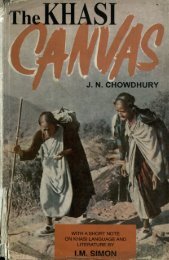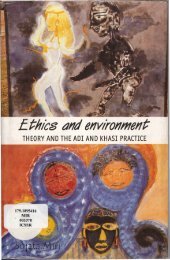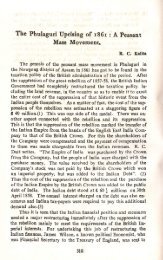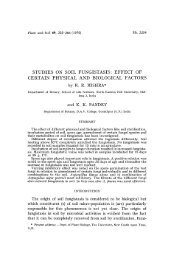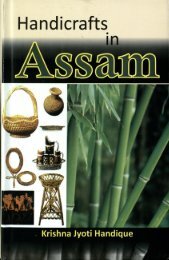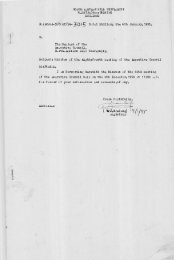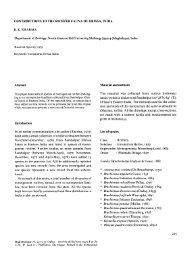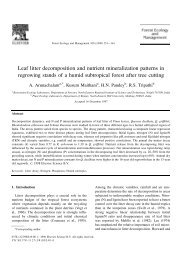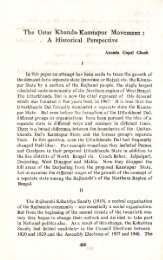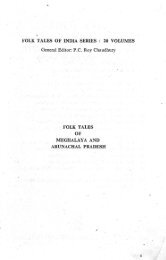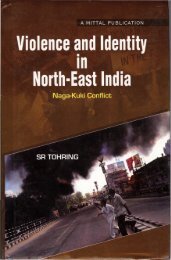Removing the veil.pdf - DSpace@NEHU
Removing the veil.pdf - DSpace@NEHU
Removing the veil.pdf - DSpace@NEHU
You also want an ePaper? Increase the reach of your titles
YUMPU automatically turns print PDFs into web optimized ePapers that Google loves.
RelDoving <strong>the</strong> Veil<br />
ISSUES IN<br />
NORTHEAST<br />
CONFLICT<br />
by<br />
Aheibam Koireng Singh<br />
Shukhdeba Sharma Hanjabam<br />
Sanasam Amal<br />
I~I<br />
w_<br />
Ef fENTIAL BOOKf<br />
NEW DELHI-110 002
B03.60QS G<br />
SIN;i.<br />
<strong>Removing</strong> <strong>the</strong> Veil Issues in Nor<strong>the</strong>ast Conflict<br />
© Author<br />
First Edition 2012<br />
All rights reserved. No part of this publication may be<br />
reproduced, stored in a retrieval system or transmitted, in any ,<br />
form or by means, electronic, mechanical, photo copying,<br />
recording or o<strong>the</strong>rwise, without <strong>the</strong> prior permission of <strong>the</strong><br />
publisher.<br />
Published by:<br />
Ef fENllAl BOOKf<br />
Sales Office: 4264/3, IInd Floor,<br />
Ansari Road, Daryaganj,<br />
New Delhi - 110002<br />
Ph.: 011-65156284<br />
Regd. Office: 95, Medha Apartments,<br />
Mayur Vihar, Phase-I<br />
Delhi - 110091<br />
Ph.: 011-22743537<br />
E-mail: essentialbooks@rediffmail.com<br />
Printed at: Harmain Offset Press, Delhi<br />
-
PREFACE<br />
The "Vision 2020" brought out by Ministry of Development<br />
of North Eastern Region (DONER) and North Eastern Council<br />
(NEC) had acknowledged that <strong>the</strong> North East being troubled by<br />
history and geo-politics has remained one of <strong>the</strong> most backward<br />
regions of <strong>the</strong> country. And that conflict has taken a heavy toll on<br />
economic progress and people's happiness in <strong>the</strong> region. With most<br />
of <strong>the</strong> outfits in <strong>the</strong> Nor<strong>the</strong>ast, ei<strong>the</strong>r already in peace talk or<br />
ceasefire with <strong>the</strong> state, it is mostly <strong>the</strong> Meitei (Manipur) led outfits<br />
which are still eluding <strong>the</strong> offer for peace talks. To cite Johan<br />
Galtung (2004), all conflicts are not game to be won or lost but are<br />
often a struggle to survive, for well-being, freedom, identity to<br />
fulfill all basic human needs. Though <strong>the</strong>re might be justifications<br />
and even many takers, conflicts in <strong>the</strong> Nor<strong>the</strong>ast can simply be not<br />
taken as 'mindless violence'. It is with <strong>the</strong> humble intention to<br />
delve deep into <strong>the</strong> issues concerning conflicts in Nor<strong>the</strong>ast that<br />
all three of us sharing a similar area of study interests came toge<strong>the</strong>r<br />
to bring out this volume. But due to our limitations, this time<br />
particular reference and focus is more on Manipur. In <strong>the</strong> near<br />
future, we intend to engage in a more exhaustive and exploratory<br />
study of <strong>the</strong> conflicts in <strong>the</strong> region which we would later<br />
subsequently disseminate it as published volume(s).<br />
The opening chapter of this book titled Understanding<br />
Conflict apprises some of <strong>the</strong> significant, original contributions of<br />
conflict and its interrelated field by eminent scholars and<br />
practitioners. It offers <strong>the</strong> <strong>the</strong>oretical underpinnings that give an<br />
idea on <strong>the</strong> fundamental social psychological processes involved<br />
in understanding and managing conflicts at all levels. It also tries<br />
to understand <strong>the</strong> conflict putting into <strong>the</strong> perspectives of North<br />
East India.<br />
The Second chapter titled, Conflict Situation in Manipur
iv<br />
vividly highlights <strong>the</strong> genesis of conflict situation in Manipur. It<br />
articulates that <strong>the</strong> conflict situation in which Manipur has been<br />
caught in is not just one clear cut conflict but conflicts of different<br />
kinds and in its multiple. In fact, Manipur can be considered as<br />
'India's ethnic minefield' and 'conflict hotspots'. It concludes<br />
that <strong>the</strong> conflict between <strong>the</strong> state and <strong>the</strong> non state armed<br />
opposition groups, ethnic conflict between and among different<br />
communities and fratricidal factional infighting between different<br />
armed groups are <strong>the</strong> specificities that gives Manipur a stamp of<br />
being in conflict situation.<br />
Conflict Situation in Manipur and Women, which constitutes<br />
<strong>the</strong> third chapter of this volume, tries to prove a point how women<br />
constitute <strong>the</strong> most vulnerable sections in an environment ripe with<br />
conflict on <strong>the</strong> basis of what had actually experienced in Manipur.<br />
In Manipur, situations of conflict whe<strong>the</strong>r it be ethnic war or<br />
between state forces and armed opposition groups women have<br />
been targets of violence irrespective of who <strong>the</strong> actor is. Women<br />
groups have time and again condemned violence and voiced <strong>the</strong>ir<br />
longing for peace. Despite it, no concerted effort could be seen<br />
from <strong>the</strong> side of <strong>the</strong> state and <strong>the</strong> NGOs to involve women in actual<br />
negotiation. Considering <strong>the</strong> enormous impact conflict situation<br />
had on women, it is imperative to study and documents <strong>the</strong> depth<br />
and dimensions of violence against women in conflict to address<br />
<strong>the</strong>ir needs in such situations. The existing state commission for<br />
women should be given more autonomy. Statutory intervention to<br />
work out strategies to involve women in decision making roles in<br />
conflict resolution and peace processes are also required and lacuna<br />
in <strong>the</strong> existing legal system and judicial mechanism in ensuring<br />
justice to women violated against in such situations should be<br />
looked into so as to done away with it.<br />
The fourth chapter titled, Revisiting Manipur's Merger and<br />
India's Exclusive politics vis-a-vis Manipur, discusses how <strong>the</strong><br />
democratic experiment in Manipur was made short-lived as merger<br />
to India sabotaged it by dissolving <strong>the</strong> elected people's government<br />
and fur<strong>the</strong>r imposing central rule in Manipur (1949-72). It also
v<br />
argues that <strong>the</strong> political void brought about by merger subsequently<br />
led <strong>the</strong> tribal communities in Manipur which previously supported<br />
Manipur's sovereignty to start mobilizing <strong>the</strong>mselves demanding<br />
for territory rights. It fur<strong>the</strong>r discusses <strong>the</strong> movement for restoration<br />
of sovereignty of Manipur in juxtaposition with <strong>the</strong> Naga<br />
Integration movement or Greater Nagaland and <strong>the</strong> issue of Greater<br />
Mizoram and/or Zalengam of <strong>the</strong> Chin- Kuki-Mizo group.<br />
Meitei Script and Ethnic Tension in Manipuri which<br />
constitutes <strong>the</strong> fifth chapter attempt to highlight <strong>the</strong> tension and<br />
conflict which arose over <strong>the</strong> issue of Meitei/Meetei Mayek (script)<br />
movement. The chapter builds up on <strong>the</strong> surmise that in a polyglot<br />
State like Manipur one common language is essential for <strong>the</strong> people<br />
of different ethnic groups speaking different tongues to express<br />
<strong>the</strong>ir views among <strong>the</strong>mselves in <strong>the</strong>ir common parlance and dayto-day<br />
life. Manipuri or Meiteilon is <strong>the</strong> only language used for<br />
this purpose as <strong>the</strong> lingua franca of this state. As such this language<br />
is understood and spoken by all <strong>the</strong> members of <strong>the</strong> Manipur<br />
Legislative Assembly irrespective of whe<strong>the</strong>r <strong>the</strong>y belong to hill<br />
or valley to express <strong>the</strong>ir views. This particular language written<br />
in Bengali script is replaced by <strong>the</strong> indigenous Meitei script and<br />
imposed in educational institutions. The outcome is ethnic conflict<br />
and tension. The tribal ethnic groups in four hills district take it as<br />
forcible imposition and a plan to assimilate <strong>the</strong> tribal culturally,<br />
linguistically and historically into <strong>the</strong> 'dominant Meitei stream.'<br />
The debate in connection with <strong>the</strong> fixing of alphabets among Meitei<br />
scholars and <strong>the</strong> political intervention; <strong>the</strong> perception and response<br />
of <strong>the</strong> common people; and <strong>the</strong> reaction of <strong>the</strong> tribal ethnic groups<br />
are important aspect of this chapter.<br />
The sixth chapter, CHIKIM Insurgencies in Manipur: Recent<br />
Developments traces how Ceasefire with CHIKIM armed outfits<br />
commenced as a military initiative sidelining <strong>the</strong> state government<br />
following <strong>the</strong> signing of SoO between <strong>the</strong> Indian armed forces<br />
and eight CHIKIM outfits on 01 August 2005 which later became<br />
official with <strong>the</strong> signing of tripartite agreement on 22 August 2008<br />
between <strong>the</strong> conglomerate groups of CHIKIM outfit namely, <strong>the</strong>
Vl<br />
UPF, and <strong>the</strong> KNO, State Government and <strong>the</strong> Centre with definite<br />
ground rules that ensures territorial integrity of Manipur, among<br />
various o<strong>the</strong>rs. It reiterates that those CHIKIM outfits under SoO<br />
should not be engaged in counter-insurgency operations should<br />
not be done as it would escalate hostilities among armed outfits as<br />
rivalries between <strong>the</strong> armed outfits often have a trickled down effect<br />
among <strong>the</strong> people whom <strong>the</strong>y claimed to represent. Though<br />
different warring groups and factions have come under SoO, <strong>the</strong>re<br />
is little evidence that <strong>the</strong>ir hostilities have ceased. JMGs should<br />
motivate <strong>the</strong> armed groups under SoO to initiate confidence<br />
building measures among <strong>the</strong> warring factions and groups to sort<br />
out <strong>the</strong>ir differences without resorting to violence. It looks forward<br />
that SoO being <strong>the</strong> first ever peace initiative involving <strong>the</strong> state<br />
government, should pave way for substantive dialogue towards<br />
durable solution of <strong>the</strong> hydra-headed CHIKIM insurgencies.<br />
Successful resolution of <strong>the</strong> CHIKIM insurgency through SoO<br />
would invite <strong>the</strong> willingness of o<strong>the</strong>r outfits which still eludes <strong>the</strong><br />
peace-talks offer.<br />
Bullet-Ballot Cocktail in Manipur Electoral Politics which<br />
constitutes <strong>the</strong> seventh chapter highlights some of <strong>the</strong> instances of<br />
involvement of extra-constitutional forces in changing <strong>the</strong> electoral<br />
outcome in <strong>the</strong> state of Manipur more so in <strong>the</strong> Assembly Elections<br />
of 2007. The people of Manipur who were traditionally under<br />
monarchy for centuries started feeling <strong>the</strong> necessity of establishing<br />
a responsible government in Manipur. So much before <strong>the</strong> first<br />
General Election in India in 1952, election on <strong>the</strong> basis of Universal<br />
Adult Franchise and Sacred Ballot under Manipur State<br />
Constitution Act, 1947 was held in Manipur in 1948 for <strong>the</strong> first<br />
time in <strong>the</strong> whole of Indian subcontinent. However this democratic<br />
experiment was short lived as <strong>the</strong> Merger Agreement (to India)<br />
put an abrupt end to it. As a result of merger of Manipur to Indian<br />
Union on 15 October 1949, Manipur became a Part C State of<br />
India on 26 January 1951. After prolonged agitations and<br />
demonstrations, Manipur was finally granted statehood on 21<br />
January 1972. Ever since Manipur attained statehood in <strong>the</strong> year
vii<br />
1972 nine state assembly elections have so far been held till <strong>the</strong><br />
year 2007. With more than thirty militants group operating in <strong>the</strong><br />
state, each having <strong>the</strong>ir area of influence and operation, <strong>the</strong><br />
prevailing scenario was more critical than that of Kashmir. Their<br />
objective ranges from secessionism to ethnic homeland and tribal<br />
autonomy, These outfits, if not all, some of <strong>the</strong>m involved in one<br />
way or <strong>the</strong> o<strong>the</strong>r in <strong>the</strong> electoral politics (held under Indian<br />
Constitution).<br />
The concluding chapter titled, Manipuri Diaspora and<br />
Homeland Conflict, is a slight departure from <strong>the</strong> previous chapters<br />
but it is a none<strong>the</strong>less relevant issue in <strong>the</strong> conflict of <strong>the</strong> region.<br />
The phenomenon of Diaspora is brought to <strong>the</strong> public domain and<br />
debate more than ever with <strong>the</strong> dawn of <strong>the</strong> new Millennium.<br />
Empirically and <strong>the</strong>oretically, it has become significant in social<br />
science research. This chapter highlights <strong>the</strong> Manipuris settled in<br />
Bangladesh as a 'Conflict-Generated Diaspora' community. The<br />
settlement of Manipuris in Bangladesh is estimated to be 250 years<br />
old. In spite of <strong>the</strong>ir long settlement in <strong>the</strong> foreign land <strong>the</strong>y exhibit<br />
<strong>the</strong> intention of retaining several social pattern and cultural<br />
elements of <strong>the</strong>ir homeland Manipur. It contended that <strong>the</strong><br />
Manipuri Diaspora communities in Bangladesh are often key actor<br />
in homeland conflict and are one of <strong>the</strong> mechanisms by which<br />
local conflicts are globalized.<br />
Many people have helped in bringing out this volume. First<br />
of all heartfelt thanks is extended to Prof. C.D. Singh, Hon'ble<br />
Vice Chancellor, Indira Gandhi National Tribal University<br />
(IGNTU), Amarkantak, Madhya Pradesh for his whole-hearted<br />
support and words of encouragement. Prof. Amar Yumnam,<br />
Director of Centre for Manipur Studies (CMS), MU has been kind<br />
enough to be lenient to <strong>the</strong> authors, Aheibam Koireng Singh and<br />
SanasamAmal in discharging <strong>the</strong>ir official duties so that <strong>the</strong>y could<br />
go ahead for bringing out this volume. In <strong>the</strong> same manner, Mr.<br />
Oliver Monsang, OSD, IGNTU, Regional Campus, Manipur has<br />
extended generous support to Shukhdeba Sharma to go ahead with<br />
<strong>the</strong> academic venture of. bringing out this volume. Their major
viii<br />
encouragement and support has ensured that this volume sees <strong>the</strong><br />
light of <strong>the</strong> day. Most of book chapters have undergone major<br />
improvement after discussing with Prof. K. Ibo and Prof. S. Mangi<br />
of Dept. of Political Science, Manipur University (MU), Prof. J.J.<br />
Roy Burman, School of Social Science, Tata Institute of Social<br />
Science, Mumbai and Hanjabam Isworchandra, Research Scholar<br />
in Economics Dept., MU. Thanks are also due to Oinam Goldflag<br />
for typesetting <strong>the</strong> manuscript of this volume in <strong>the</strong> least possible<br />
time. Heartfelt thanks are also extended to Grace Laltinzo, Asst.<br />
Prof., Dept. of Social Work, IGNTU-RC, Manipur and Raginibala<br />
Pukhrambam for thoroughly going through and proof reading <strong>the</strong><br />
manuscript very efficiently. The unstinted support, encouragement<br />
and inspiration given by Dr. Sushma Phurailatpam are also<br />
gratefully acknowledged.<br />
Authors
AC<br />
ADC<br />
AFSPA<br />
ANSAM<br />
AR<br />
BBC<br />
BJP<br />
CHIKIM<br />
CM<br />
CPI<br />
CRN<br />
CRPF<br />
DGP<br />
DONER<br />
FGN<br />
Gol<br />
GPRN<br />
HQ<br />
HPC<br />
lAP<br />
IB<br />
ICP-JAC<br />
IGAR<br />
nc<br />
INC<br />
INF<br />
IPS<br />
JMG<br />
KCA<br />
KCP<br />
KDF<br />
KIF<br />
ABBREVIATIONS USED<br />
Assembly Constituency<br />
Autonomous District Council<br />
Armed Forces Special Powers Act<br />
All Naga Student's Association Manipur<br />
Assam Rifles<br />
British Broadcasting Corporation<br />
Bharatiya Janata Party<br />
Chin Kuki Mizo<br />
Chief Minister<br />
Communist Party of India<br />
Committee for Restoration of Normalcy<br />
Central Reserved Police Force<br />
Director General of Police<br />
Development of North Eastern Region<br />
Federal Government of Nagaland<br />
Government of India<br />
Government of Peoples' Republic of Nagaland<br />
Head Quarter<br />
Hmar Peoples' Convention<br />
Indian Armed Forces<br />
Intelligence Bureau<br />
Integrated Check Post - Joint Action Committee<br />
Inspector General Assam Rifles<br />
India International Centre<br />
Indian National Congress<br />
Islamic National Front<br />
Indian Police Service<br />
Joint Monitoring Group<br />
Kuki Chief Association<br />
Kangleipak Communist Party<br />
Kuki Defense Force<br />
Kuki International Force
KLA<br />
KLO<br />
KMHR<br />
KNA<br />
KNF<br />
KNO<br />
KNV<br />
KRA<br />
KSO<br />
KYKL<br />
MAKAIAS -<br />
MNF<br />
MLA<br />
MNRF<br />
MoS<br />
MPCC<br />
MPP<br />
MSC<br />
MSCA<br />
NBCC<br />
NDA<br />
NEC<br />
NGO<br />
NHDTC<br />
NNC<br />
NNLA<br />
NSCN (IM) -<br />
NSCN (K)<br />
PCCP<br />
PDA<br />
PLA<br />
PREPAK<br />
PS<br />
PULF<br />
RGM<br />
x<br />
Kuki Liberation Army<br />
Kuki Liberation Organisation<br />
Kuki Movement for Human Rights<br />
Kuki National Army<br />
Kuki National Front<br />
Kuki National Organization<br />
Kuki National Volunteer<br />
Kuki Revolutionary Army<br />
Kuki Students' Organisation<br />
Kanglei Yawol Kanna Lup<br />
Maulana Abdul Kalam Azad Institute for Asian<br />
Studies<br />
Mizo National Front<br />
Member Legislative Assembly<br />
Manipur Naga Revolutionary Front<br />
Memorandum of Settlement<br />
Manipur Pradesh Congress Committee<br />
Manipur People's Party<br />
Meitei State Committee<br />
Manipur State Constitution Act<br />
Nambol Block Congress committee<br />
National Democratic Alliance<br />
North Eastern Council<br />
Non Governmental Organisations<br />
Naga Hills District Tribal Council<br />
Naga National Council<br />
Naga National Liberation Army<br />
National Socialist Council of Nagalim<br />
(IsakMuivah)<br />
National Socialist Council of Nagaland<br />
(Khaplang)<br />
Peoples' Consultative Committee for Peace<br />
Peoples Democratic Alliance<br />
People's Liberation Army<br />
People Revolutionary Party of Kangleipak<br />
Polling station<br />
Peoples' United Liberation Front<br />
Revolutionary Government of Manipur
RPF<br />
RJD<br />
SDPO<br />
SIB<br />
SOG<br />
SoO<br />
UKLF<br />
UNC<br />
UNDF<br />
UNLF<br />
UNPC<br />
UNPO<br />
UPDP<br />
UPF<br />
UPPK<br />
URRF<br />
USRA<br />
UNWGIP<br />
VPC<br />
ZDV<br />
ZRO<br />
xi<br />
Revolutionary People's Front<br />
Rastriya Janata Dal<br />
Sub Divisional Police Officer<br />
Subsidiary Intelligence Bureau<br />
Strategy and Operational Group<br />
Suspension of Operation<br />
United Kuki Liberation Front<br />
United Naga Council<br />
United Naga Democratic Front<br />
United National Liberation Front<br />
United Naga People's Convention<br />
Unrepresented Nations People's Organization<br />
United Peoples Democratic Party<br />
United Peoples' Front<br />
United People's Party of Kangleipak<br />
United Rem Revolutinary Force<br />
United Socialist Revolutionary Alliance<br />
United Nations Working Group on Indigenous<br />
Peoples'<br />
Vaiphei People's Council<br />
Zou Defence Volunteer<br />
Zomi Reunification Organisation
CONTENTS<br />
Preface iii<br />
Abbrievation Used ix<br />
List of Tables xv<br />
~~~~ ~<br />
Chapter 1 Understanding Conflict 1<br />
Chapter 2 Conflict Situation in Manipur 18<br />
Chapter 3 Conflict and Women: Manipur Experience 26<br />
Chapter 4 Revisiting Manipur's Merger and 31<br />
India's Exclusive politics vis-a-vis Manipur<br />
Chapter 5 Meitei Script And Ethnic Tension In Manipur 48<br />
Chapter 6 CHIKIM Insurgencies in Manipur: 60<br />
Recent Developments<br />
Chapter 7 Bullet-Ballot Cocktail in Manipur 75<br />
Electoral Politics<br />
Chapter 8 Manipuri Diaspora and Homeland Conflict 91<br />
Annexure 1 103<br />
Annexure 2 116<br />
Bibliography 119<br />
Index 125
LIST OF TABLES<br />
Table No 1 Categories of Contention 2<br />
Table No 2 Sources of Conflict: Level of 4<br />
Analysis Approach<br />
Table No 3 Overview and definitions of 6<br />
<strong>the</strong> conflict intensity<br />
Table No 4 Theories of Conflict 8<br />
Table No 5 Dealing with Conflict 14<br />
Table No 6 Resistance groups Supporting 38<br />
Sovereignty of Manipur<br />
Table No 7 Kuki-Chin-Mizo underground group who 44<br />
have signed Suspension of Operation with<br />
<strong>the</strong> Government of Manipur/ India
LIST OF FIGURES<br />
Fig No 1 Life Cycle of a Conflict 7<br />
Fig No 2 Manipur areas demanded by 41<br />
NSCN (IM) to merger/Integrate<br />
with Nagaland<br />
Fig No 3 Manipur areas demanded by 43<br />
CHIKIM underground groups<br />
to form Kukiland or Zalengam
CHAPTER l'<br />
.. .<br />
UNDERSTANDING CONFLICT'<br />
Introduction:<br />
Conflict and violence are inevitable aspects of human<br />
behavior and social relationships. The history of conflict can be<br />
traced back to <strong>the</strong> beginning of human history and will probably<br />
never end. It does not exist at a higher or lower levels as all<br />
conflicts are born equal and have <strong>the</strong> same right to be processed,<br />
with transcendence ('going beyond') and transformation, so that<br />
<strong>the</strong> parties can live with <strong>the</strong>m. Geopolitical conflicts are not 'higher<br />
level' because statesmen and diplomats have high social status.<br />
All conflicts are not game to be won or lost, but are often a struggle<br />
to survive, for well-being, freedom, identity-all basic human needs.<br />
He describes conflict in a simple diagrammatic representation. J<br />
Conflict = Attitudes(Hatred) + Behaviour(Violence)<br />
+ Contradiction (Issue)<br />
! "<br />
Conflict involves disputes over issues and interests that may<br />
lead to violence or <strong>the</strong> use of force whose legitimacy may be,<br />
contested. It can be broadly understood when two or more 'parties'<br />
(individuals or group) have - or believe <strong>the</strong>y have-incompatible<br />
goals, and this perception of incompatibility shapes <strong>the</strong>ir attitudes<br />
and behaviors toward each o<strong>the</strong>r. The most destructive types of<br />
conflict such as interstate and civil wars consist of a coercive,<br />
violent mode of confrontation among adversaries. Whereas conflict<br />
embraces personal loss and societal destruction, its features are<br />
not limited to physical violence. Non-violent forms of struggle<br />
are also prevalent in pursuit of different values and scare resources.<br />
.'
2/ <strong>Removing</strong> <strong>the</strong> Veil Issues in North-East Conflict<br />
In bringing about important social change, resorting to force is<br />
nei<strong>the</strong>r necessary nor inevitable. Our survival is centered on how<br />
we manage <strong>the</strong> various features of conflict. 2<br />
SI.No Particular<br />
1.<br />
Table No 1: Categories of Contention<br />
Arguments<br />
2. Disputes<br />
3. Deep Rooted<br />
Conflict<br />
Explanation<br />
These occur when parties have similar<br />
interests and goals but disagree over <strong>the</strong><br />
means of achieving <strong>the</strong>m. For Example,<br />
They agree that <strong>the</strong>re should be training<br />
on <strong>the</strong>ir equal opportunities but disagree<br />
on how to organize it.<br />
. These are situations where <strong>the</strong> parties<br />
have incompatible interests and goals.<br />
Yet <strong>the</strong>y can be framed as issues of gain<br />
or loss, <strong>the</strong>y can be negotiated. (for<br />
example, a group representing people<br />
with physical disabilities demands that<br />
all public transport is fully accessible,<br />
but <strong>the</strong> government claims it will be too<br />
expensive; <strong>the</strong>y <strong>the</strong> negotiated a<br />
agreement for increasing accessible<br />
routes over ten years<br />
These involve <strong>the</strong> basic needs-such as<br />
survival, security, recognition, and<br />
identity- of one or more of <strong>the</strong> parties,<br />
and <strong>the</strong> perception that <strong>the</strong>se needs are<br />
threatened by <strong>the</strong> o<strong>the</strong>r.<br />
Source: Simon Fisher, Dekha Ibrahim Abdi, Jawed Ludin, Richard<br />
Smith, Steve Williams; &. Sue Williams, Working with Conflict:<br />
Skills & Strategies for Action, Zed books in Association wjth<br />
Responding to Conflict, 2005, p 12).<br />
'- ~~
Understanding Conflict / 3<br />
It is generally believed that conflict is negative but it has<br />
its positive side too. It helps to reveal <strong>the</strong> underlying problems<br />
that need to be addressed to keep <strong>the</strong> system of relationships<br />
dynamic and strong. An open conflict often releases considerable<br />
energy that can be channeled in many directions by trying to<br />
respond to <strong>the</strong> situation. Sometimes, peoples respond to conflict<br />
by seeking to avoid it or suppress it, or by <strong>the</strong> use of aggression<br />
or even violence against those <strong>the</strong>y see as creating <strong>the</strong> problem or<br />
blocking <strong>the</strong> goals. Yet, it is possible to work with conflict in a<br />
way that enable people to address <strong>the</strong> cause and to repair <strong>the</strong><br />
relationships that have been weakened by anger, fear or even hatred<br />
generated by conflict. It can also be embraced as a way of working<br />
proactive towards social change and o<strong>the</strong>r activism. The ways we<br />
respond to <strong>the</strong> conflict make <strong>the</strong> difference of whe<strong>the</strong>r it becomes<br />
a force for destruction or being a catalyst for constructive changes.'<br />
The case of South Africa and many countries which have<br />
successfully transformed from <strong>the</strong> violent era to a peaceful country<br />
is a case in point.<br />
For many centuries, it has affected <strong>the</strong> people ei<strong>the</strong>r directly<br />
or indirectly through various ways and intensity. The mass<br />
extermination of <strong>the</strong> regime's enemy classes in <strong>the</strong> mid-1970s<br />
was marked by a million deaths; <strong>the</strong> genocide in Rwanda that<br />
cost more than a million lives. The civil war in Sudan and Congo<br />
cost more than four millions ei<strong>the</strong>r by directly and indirectly. The<br />
ethnic cleansing of Bosnia-Herzegovina; <strong>the</strong> war in Chechnya and<br />
<strong>the</strong> civil population in Iraq as a consequence of US Invasion are<br />
worth mentioned.' Coming closer to home, <strong>the</strong> Naga-Kuki clash<br />
in early 90s cost hundreds of civilian lives besides destruction of<br />
properties. According to Uppsala Conflict Data Programme, <strong>the</strong>re<br />
are 36 active armed conflicts in 2008. The biggest increase<br />
occurred in Africa, from nine in 2003, seven in 2005 to 12 in<br />
2008. While <strong>the</strong> number of conflicts continued to increase, <strong>the</strong><br />
number of wars (i.e. conflicts with over 1,000 battle-related deaths)<br />
remained at a very low level, with only five recorded in 2008. 5<br />
Stockholm International Peace Research Institute (SIPRI-<br />
Handbook 2009) reported 16 major Armed Conflict in 15 locations<br />
around <strong>the</strong> world in 2008. Manipur is reported as one of <strong>the</strong>
4/ <strong>Removing</strong> <strong>the</strong> Veil Issues in North-East Conflict<br />
ongoing armed self-determination movement in <strong>the</strong> world."<br />
. .:~ .•~~":"<br />
T~bi~;No2: Sources of Conflict: Level of Analysis Approach<br />
I",,' "<br />
/ '"<br />
,<br />
Level Example<br />
I<br />
'i,.,.<br />
GLOBAL Geo-political Transition:<br />
North-South Divide<br />
REGIONAL Clientage Patterns, Cross<br />
Border Demography<br />
STATE Social Weak Society; Cultural<br />
Division; Ethnic Imbalances<br />
Economics Weak Economy; Poor Resource<br />
Base; Relative Deprivation<br />
Political Weak Polity; Partisan<br />
Government; Regime<br />
Illegitimacy<br />
CONFLICT Group Mobilization; Inter-<br />
PARTY Group Dynamics<br />
ELITE/ Exclusionist Policies; Factional<br />
INDIVIDUAL Interest; Rapacious Leadership<br />
Source: Responding to Conflict, 2005, p 36<br />
Types of Conflict:<br />
Jurgen-Axt? observed that, ontologically, research into <strong>the</strong><br />
sources and categories of conflict is usually centered on two<br />
approaches: <strong>the</strong> subjective and <strong>the</strong> objective approach. The<br />
objective approach looks for <strong>the</strong> origin of conflict in <strong>the</strong> social<br />
and political make-up and structure of <strong>the</strong> society. It considers <strong>the</strong><br />
goals at stake can be thoroughly compatible. On <strong>the</strong> contrary, <strong>the</strong><br />
subjective primarily focuses on <strong>the</strong> perceived incompatibility of<br />
goal and differences. The level of incompatibility is <strong>the</strong> most<br />
important variable that impact <strong>the</strong> int~p~ity of dispute and dynamic<br />
of conflict phase. It can be categorized in terms of types of actors<br />
and adversarial action, ranging from war to non-violent struggles."<br />
Various research centers and Individuals have classified <strong>the</strong>
Understanding Conflict / 5<br />
types of conflict in various ways. Among <strong>the</strong>m, Uppsala Conflict<br />
Data Program (UCDP) types Conflict as (i) Minor; (ii) Intermediate<br />
and (iii) Major Armed Conflict. The International Committee of<br />
<strong>the</strong> Red Cross (ICRC) and Red Crescent Movement classified <strong>the</strong><br />
conflict as (i) International Armed Conflict and (ii) Non-<br />
International Armed Conflict. Galtung? observed three types of<br />
conflict in terms of <strong>the</strong> goals: (i) The goals of all parties have<br />
(some) legitimacy; (ii) The goals of some parties are legitimate,<br />
of o<strong>the</strong>r not; (iii) The goals of all parties are illegitimate. Fur<strong>the</strong>r,<br />
He (2004) classified conflict into four types (i) Micro -Conflict<br />
within and between people; (ii) Meso-Conflicts within Societies;<br />
(iii) Micro-Conflict among States and Nations and (iv) Mega-<br />
Conflict Among Regions and Civilizations.<br />
Stages of Conflict:<br />
Conflict always passes through a series of phases with<br />
distinct intensity: beginning, development,· and end.'? The<br />
classification of <strong>the</strong> stages of conflict is done by many research<br />
institutes and individuals but in this paper, few of <strong>the</strong>m are<br />
discussed. It is not because <strong>the</strong>y are <strong>the</strong> most prominent but <strong>the</strong><br />
stages under discussion will give a general understanding of <strong>the</strong><br />
classification. Galtung" observed that a conflict has its own life<br />
cycle; almost like something organic. It appears, reaches an<br />
emotional, even violent climax, <strong>the</strong>n tapers off, disappear - and<br />
often reappear. The life cycle may be divided into three phases,<br />
(i) before violence; (ii) during violence; and (iii) after violence,<br />
separated by outbreak and cease-fire. This does not imply that<br />
violence is unavoidable, or that conflict equals to violence or<br />
destruction.
Table No 3: Overview and definitions of <strong>the</strong> conflict intensity"<br />
State of Intensity Level Name Definition<br />
Violence Group of of<br />
intensity intensity<br />
Non- Violent Low 1 Latent<br />
Conflict<br />
2 Manifest<br />
Conflict<br />
Violent Medium 3 Crisis<br />
High 4 Severe<br />
Crisis<br />
5 War<br />
"<br />
and of long duration.<br />
0'\<br />
Latent<br />
Conflict<br />
Conflict<br />
Escalation<br />
Conflict<br />
Emergence<br />
Understanding Conflict / 7<br />
(Hurting) Stalemate<br />
De-escalation/Negotiation<br />
Dispute Settlement<br />
Post-Conflict<br />
Peacebuilding<br />
Time<br />
Figure No 1: Life Cycle of a Conflict: 13<br />
The Conflict Early Warning System research project (cited<br />
in Jurgen Axt 2006)14, have classified <strong>the</strong> stages of conflict into<br />
six phases:<br />
• Dispute phase, (opposing claims expressed through<br />
existing institutional processes);<br />
• Crisis phase, (opposition use existing institutional<br />
processes, but <strong>the</strong>ir substitution with violence is openly<br />
. threatened or expected); -<br />
• Limited violence phase, (legitimacy or usefulness of<br />
institutional processes is question, 'and systematic and<br />
regular use of force is considered justified);<br />
• Massive violence phase, (regular, systematic, and<br />
unrestrained use of force; institutional processes for<br />
peaceful settlement are disabled or avoided,);<br />
• Abatement phase, (actions leading to temporary<br />
suspension of opposition, use of violence, and<br />
expectations), and<br />
• Settlement phase (resolution of opposing claims and<br />
establishmentor re-establishmentof mutually recognized<br />
institutional processes).<br />
Theories of Conflict<br />
Most conflict involves value difference and power<br />
disparities, whereas misperception and miscommunication plays<br />
an important role in <strong>the</strong> evolution of adversarial relationship. Even<br />
though a conflict originates from economic and o<strong>the</strong>r material
8/ <strong>Removing</strong> <strong>the</strong> Veil Issues in North-East Conflict<br />
sources, it can be quickly expanded to identity differences with<br />
escalation. In most complex situation, a variety of issues, such as<br />
<strong>the</strong> availability of resources and basic human needs, are interrelated<br />
with each o<strong>the</strong>r. The sources and actors may differ according to<br />
<strong>the</strong> interest of <strong>the</strong> conflict. The sources of adversarial relationship<br />
are not limited to tangible economic interest or control over power,<br />
but also extend to values and identity differences. 15<br />
Conflict can be analyzed and understood from various<br />
disciplines-economics are focused on game-<strong>the</strong>ory and decision<br />
making, psychologist explore interpersonal conflicts, sociologist<br />
takes status and class conflicts as <strong>the</strong> focal point while political<br />
science is focused on intra-national and international conflicts."<br />
The emerging discipline of peace and conflict studies has its own<br />
understanding of conflict. It may be a possibility of one <strong>the</strong>ory<br />
explaining <strong>the</strong> conflict but in most cases, <strong>the</strong> understanding of <strong>the</strong><br />
conflict need multiple or holistic approaches. Some of <strong>the</strong> <strong>the</strong>ories<br />
that will help in understanding conflict are explained below.<br />
Table No 4: Theories of Conflict<br />
SI No Theory Key Ideas and Assumption<br />
1 Basic Human Deep rooted Conflict is <strong>the</strong> result of <strong>the</strong><br />
Needs failure to satisfy human needs for<br />
identity and security<br />
2 Rational Actor: All actions are motivated by <strong>the</strong> quest<br />
Realistic for power dominance<br />
3 Rational Actor: Armed Conflict are manifestations of<br />
Economic economic processes: competition of<br />
scare resources; economic discrimination<br />
and relative deprivation; greed vs.<br />
grievance; and predatory war economics<br />
4 Political Political actors use conflict to mobilize<br />
Sociology a power base among identity groups or<br />
social classes. Integrating functions of<br />
conflict and role of cross-cutting ties;<br />
Contd .
Understanding Conflict / 9<br />
significance of social dislocation and<br />
economic, demographic and ecological<br />
change<br />
5 Primordialisml They have never been able to get along:<br />
Ancient Hatred clash of civilization<br />
6 Psychodynamics IFrustration- aggression; stereotype, fear<br />
/Social- of difference; communal identity and<br />
Psychological systemized victirnhood, social learning<br />
and obedience to authority<br />
7 Gender, Power Men/Boys and Women/girls can<br />
and Violence experience conflict and violence<br />
differently, all must be taken into account<br />
to address conflict constructively and<br />
equitably- especially given <strong>the</strong> globally<br />
predominant patterns of discriminations<br />
against women or patriarchal system of<br />
male dominance; masculinity and<br />
femininity are socially constructed<br />
norms, that in many societies are<br />
constructed to assign <strong>the</strong>m different<br />
social roles, including in relation to<br />
violence and conflict.<br />
8 Systematic Each conflict is embedded in a wide<br />
system that contributes to root causes,<br />
influences processes and dynamics for<br />
how it plays out; world systems <strong>the</strong>ory;<br />
dependency <strong>the</strong>ory; globalization, new<br />
wars and network wars.<br />
Sources: Responding to Conflict, 2005, p 37'7<br />
Manifestation of Conflict:<br />
The manifestation of <strong>the</strong> conflict is reflected in various<br />
ways and intensity. Singer points out that "<strong>the</strong> usual suspects" are<br />
to be found in: territory, ideology, dynastic legitimacy, religion,<br />
language, ethnicity, self-determination, resources, markets,
10/ <strong>Removing</strong> <strong>the</strong> Veil Issues in North-East Conflict<br />
dominance, equality, and, of course, .revenge. Having <strong>the</strong> interstate<br />
conflicts in <strong>the</strong> focus, Pfetsch and Rohloff have identified nine<br />
commodities that have historically proven to be <strong>the</strong> most disputed<br />
conflict issues between <strong>the</strong> states: territory (border), secession,<br />
decolonization, autonomy, system (ideology), national power,<br />
regional predominance, international power, resources and o<strong>the</strong>r. IS<br />
The conflict in India particularly North Eastern India is mostly<br />
confined to <strong>the</strong> issue of territory while that of Central and Nor<strong>the</strong>rn<br />
India (Naxalite) are most over <strong>the</strong> issue of ideology.<br />
Conflict Situation:<br />
The essential nature of conflict situation is easily understood<br />
is terms of <strong>the</strong> difficulties involved in meeting everyone's<br />
aspiration simultaneously (cited in Jeong Ho-Won, 2008, P 5).19<br />
The most common accepted description of a conflict situation<br />
focuses not only on incompatible ends but also on irreconcilable<br />
relationships. Goals and activities become incompatible when one's<br />
own interests are threatened by <strong>the</strong> action of o<strong>the</strong>rs. Parties to<br />
conflict make attempt to prevent each o<strong>the</strong>r from achieving desired<br />
objectives, in parts, owing to perception of divergent interest.<br />
Tensions essentially emerge due to <strong>the</strong> pursuit of different<br />
outcomes or disagreement on <strong>the</strong> means to attain <strong>the</strong> same end.<br />
Thus a conflict situation is represented by perceived goal<br />
incompatibilities and attempts to control each o<strong>the</strong>r's choice, which<br />
generates adverse feelings and behaviors towards each o<strong>the</strong>r (Jeong<br />
Ho-Won, 2008,).20<br />
The contradictory claims to scare status, power, and<br />
resources are often represented in purposeful efforts made by actors<br />
to defeat, thwart, remove, or at least neutralize <strong>the</strong>ir rivals (cited<br />
in Jeong Ho-Won, 2008, P. 11)21.Thus, conflict processes involves<br />
direct and indirect effort to undermine <strong>the</strong> adversaries' goal seeking<br />
capacity. The North Eastern India particularly Manipur has been<br />
in a conflict situation since <strong>the</strong> late 40s. On one hand, <strong>the</strong> nonstate<br />
actors have stuck <strong>the</strong>ir demands of sovereignty of Manipur<br />
since <strong>the</strong> inception of <strong>the</strong> movement in <strong>the</strong> late 40s by Legendary<br />
Leader Hiram Irabot. On <strong>the</strong> o<strong>the</strong>r hand, <strong>the</strong> Government of India<br />
has so far stuck not to allow any part of India to secede. The
Understanding Conflict / 11<br />
question of restoration of Manipur sovereignty and secession from<br />
India has generated a conflict situation which is directly and<br />
indirectly severely impacted on <strong>the</strong> society.<br />
Conflict in North. Eastern India:<br />
The first armed self-determination movement in India's<br />
North East emerged against <strong>the</strong> forceful merger of Manipur to <strong>the</strong><br />
Indian union. Force in <strong>the</strong> sense of overlooking <strong>the</strong> Manipur State<br />
Assembly which was an elected body of <strong>the</strong> people of Manipur<br />
under <strong>the</strong> Manipur State Constitution 1947; force in <strong>the</strong> sense of<br />
using military might to sign <strong>the</strong> merger. So it is annexation ra<strong>the</strong>r<br />
than merger. Legendary leader Hijam Irabot responded by an armed<br />
uprising against <strong>the</strong> merger in 1949 but it was soon crushed by<br />
<strong>the</strong> government. It was quickly followed by Naga National Council<br />
in 1956 under <strong>the</strong> leadership of Phizo for a sovereign Nagaland.<br />
The Nagas have started <strong>the</strong> non-violent opposition by declaring<br />
<strong>the</strong>mselves Independence on 14 August 1947, one day ahead of<br />
Indian Independence. The All Manipur Students Union was<br />
involved in <strong>the</strong> mass awareness among <strong>the</strong> student community of<br />
Manipur about <strong>the</strong> right to self-determination since <strong>the</strong> late 1970s.<br />
The roots for <strong>the</strong> movement in Assam and Tripura are almost<br />
same. The uprising is against <strong>the</strong> illegal migrants and grabbing<br />
<strong>the</strong> land and opportunities of <strong>the</strong> natives.<br />
As of now, PLA of Manipur is still holding on <strong>the</strong>ir demand<br />
for complete independence from India. UNLF which is one of <strong>the</strong><br />
oldest among <strong>the</strong> existing insurgent groups in Manipur have<br />
proposed plebiscite for an honorable settlement of 'Manipur-India<br />
conflict'. Though <strong>the</strong> state Chief Minister, Shri Okram Ibobi Singh<br />
had acknowledged that discussion on plebiscite that has been<br />
witnessing at various places in Manipur could be a good beginning<br />
for resolving <strong>the</strong> conflict, it is still to receive any response from<br />
<strong>the</strong> GoI. On <strong>the</strong> o<strong>the</strong>r hand, NSCN (IM) after ten year of peace<br />
talk has agreed to a "special federal relationship". Sections of<br />
ULFA are in <strong>the</strong> process of holding talk with <strong>the</strong> government but<br />
its Military Chief Paresh Baruah is against <strong>the</strong> talk. Similar is <strong>the</strong><br />
situation for Bodos. The CHIKIMs of Manipur have given up<br />
<strong>the</strong>ir demands and are now negotiating with <strong>the</strong> territory of
12/ <strong>Removing</strong> <strong>the</strong> Veil Issues in North-East Conflict<br />
Manipur. If one looks at how <strong>the</strong> insurgency started in <strong>the</strong> states<br />
of Assam, Manipur, Nagaland, even though <strong>the</strong> emergence of <strong>the</strong><br />
phenomena may vary from one social dynamics to ano<strong>the</strong>r, one<br />
still invariable finds an undercurrent of defiance of a lingering<br />
colonial force. 22<br />
Since <strong>the</strong> uprising in Manipur, Nor<strong>the</strong>ast India is<br />
continuously militarized. The Armed Forces Special Powers Act<br />
1958 was imposed, which empowers <strong>the</strong> central security forces to<br />
search, arrest and even to kill anyone on mere suspicion with<br />
impunity. The imposition is in order to suppress <strong>the</strong> movement<br />
which in turn led to massive human right violations and fur<strong>the</strong>r<br />
alienated <strong>the</strong> people. After four decades, like a nuclear chain<br />
reaction, <strong>the</strong> law has been amended a number of times to<br />
accommodate changes in <strong>the</strong> names and <strong>the</strong> number of states. It<br />
now applies to all of Nor<strong>the</strong>ast India ei<strong>the</strong>r partially or fully. By<br />
1980s <strong>the</strong> armed forces on a more regular basis as a substitute for<br />
administration and governance. The' extent of military deployment<br />
during <strong>the</strong> 1990s reveals that <strong>the</strong>re was one armed force personnel<br />
for every ten civilians in some parts of <strong>the</strong> region." O<strong>the</strong>r than an<br />
elected chief minister and an elected state legislature, <strong>the</strong>re is<br />
also a de-facto parallel structure of governance directly controlled<br />
from Delhi that manages counter-insurgency operations." The<br />
concentration of central security forces in <strong>the</strong> valley of Manipur<br />
is such that Robinson remarks it as an occupational force ra<strong>the</strong>r<br />
than <strong>the</strong> defense of <strong>the</strong> country." The GoI justification for<br />
bypassing <strong>the</strong> state/regional governments and legitimizing <strong>the</strong><br />
monopoly of violence by <strong>the</strong> centre is based on <strong>the</strong> idea of<br />
"national security".<br />
The expansion of <strong>the</strong> military and related agencies has<br />
created enormous problems for civil society. While <strong>the</strong> government<br />
complains that it has no money with which to support civil<br />
institutions, it has pumped millions of rupees every year in <strong>the</strong><br />
police and <strong>the</strong> armed forces stationed throughout <strong>the</strong> state. The<br />
security forces who are pitted in a.no win situation while fighting<br />
<strong>the</strong> militants, often resort to retaliatory violence on <strong>the</strong> common<br />
people for attacks carried out against <strong>the</strong> security forces by <strong>the</strong><br />
militants." The air force was pressed to suppress <strong>the</strong> movement
Understanding Conflict /13<br />
particularly against <strong>the</strong> Mizo National Fronts, which is an<br />
exceptional case. There are innumerable combing operations and<br />
major operations as part of <strong>the</strong> counter insurgency operations in<br />
this region. Mention can be made of Operation Rhino, Operation<br />
Bazrang, and Operation Blue Bird. Operation All Clear (2004),<br />
Operation Tornado (2005), Operation Dragnet (2006) Operation<br />
Summer Strom (2009) were conducted in Manipur. These<br />
operations were remembered by <strong>the</strong> people and Human Rights<br />
bodies because of <strong>the</strong> rampant human rights violations-especially<br />
using villagers as "human shields" to prevent possible ambushes<br />
from <strong>the</strong> militants. Considering <strong>the</strong> frequent military operations<br />
particularly in <strong>the</strong> remote areas, <strong>the</strong>re may be possibility of using<br />
air power to control <strong>the</strong> territory that <strong>the</strong> militant claims as liberated<br />
zones.<br />
Dealing with Conflict:<br />
The control of violent escalation is a main focus of conflict<br />
intervention and management, prior to seizing an opportunity for<br />
resolution. A proper policy of 'conflict prevention entails <strong>the</strong><br />
constraint monitoring of potential flash points but also immediate<br />
actions to remove <strong>the</strong> conditions that facilitate <strong>the</strong> outbreak of<br />
violence. The minimalist aim of conflict prevention is at least to<br />
block a crisis from spilling into an openly violent conflict."<br />
Dealing of conflict can do between <strong>the</strong> conflicting parties and if<br />
<strong>the</strong> consensus cannot be reach between <strong>the</strong> parties, <strong>the</strong> third party<br />
intervention is quite often considered. The forms and dealing with<br />
conflict can vary from place to place or from conflict to conflict.<br />
Reimann observed three forms of dealing with conflict, (i) Conflict<br />
Settlement; (ii) Conflict Resolution; and (iii) Conflict<br />
Transformation." Jeong Ho-Won 29 categorized two ways of dealing<br />
with conflict, (i) Conflict Management; and (ii) Conflict<br />
Resolution. Dealing of Conflict can be summarized as given below
14/ <strong>Removing</strong> <strong>the</strong> Veil Issues in North-East Conflict<br />
Table No 5: Dealing with Conflict(Endnotes)<br />
SI No Particular Ideas<br />
1 Conflict<br />
Settlement<br />
2 Conflict<br />
Management<br />
3 Conflict<br />
Resolution<br />
4<br />
Conflict<br />
Transformation<br />
It covers all conflict strategies that aim<br />
a definite end of <strong>the</strong> direct violence,<br />
without necessarily coping with <strong>the</strong> basic<br />
causes of <strong>the</strong> conflict.<br />
Efforts for preventing escalation of<br />
conflict or reducing <strong>the</strong> destructive<br />
nature of conflict; less concerned with<br />
structural condition. .<br />
It aims toward achieving satisfying<br />
solution for all parties involved. Or<br />
Dealing with root causes; satisfactory<br />
institutional changes or new social<br />
relations often required.<br />
The central <strong>the</strong>sis of this approach is<br />
based on <strong>the</strong> fact that certain<br />
transformation capacity must be present<br />
among <strong>the</strong> parties involved. By this<br />
recognizes man <strong>the</strong> ability for mutual<br />
respect and reciprocal understanding in<br />
respect of <strong>the</strong> interest in conflict that will<br />
lead both parties toward sustainable and<br />
acceptable solution.<br />
Source: compiled by Author from Jurgen Axt, (2006) and Jeong<br />
Ho-Won, (1999).30<br />
It's not that <strong>the</strong> government of India is not aware of <strong>the</strong><br />
roots causes of <strong>the</strong> self-determination movement in India's North<br />
East. The government of India has tried to resolve <strong>the</strong> Naga issue<br />
since <strong>the</strong> very beginning by signing many peace accords. Similar<br />
is <strong>the</strong> case of <strong>the</strong> Mizoram, followed by Tripura. The two decades<br />
Mizo movement was <strong>the</strong> only successful peace accord in North<br />
East India. Presently, most of <strong>the</strong> ethnic based groups are ei<strong>the</strong>r
Understanding Conflict /15<br />
into "informal" ceasefire with <strong>the</strong> Indian army or into peace<br />
negotiation with <strong>the</strong> Government of India at <strong>the</strong> ministerial level<br />
or/are into some forms of bargain. Once ULFA was declared illegal,<br />
Government of India invited for peace talk on many occasion<br />
without any result. But surprisingly, <strong>the</strong> resistance group of<br />
Manipur like <strong>the</strong> UNLF, PLA was not invited even once since <strong>the</strong><br />
beginning of <strong>the</strong> armed resistance in 1949. The reason may be<br />
multiple but one reason may be <strong>the</strong> legitimate right of <strong>the</strong> people<br />
of Manipur to self-determination, which <strong>the</strong> government of India<br />
does not want to expose to <strong>the</strong> international community by<br />
initiating a peace talk.<br />
Co-option and military operations has been <strong>the</strong> main<br />
instrument for dealing with <strong>the</strong> conflict in India particularly in<br />
Kashmir, Punjab or in <strong>the</strong> Nor<strong>the</strong>ast. Military operations have<br />
been <strong>the</strong> immediate response of <strong>the</strong> state. But once <strong>the</strong> insurgency<br />
lost its sting, political dialogue was promptly initiated by offering<br />
political autonomy and pumping cores of rupees. It is largely<br />
influenced by <strong>the</strong> real politik propounded by Kautilya (also called<br />
Chanakya), who helped King Chandragupta Maurya to build<br />
India's first trans-regional empire just after Alexander's invasion<br />
of India. Kautilya advocated Sham (conciliation), Dam (Bribe),<br />
Danda (Forces), and Bhed (Split) as <strong>the</strong> four options of statecraft<br />
to be used in effective combinations ra<strong>the</strong>r than as single, standards<br />
options. If <strong>the</strong> insurgent groups insist on sovereignty or adopted<br />
positions unacceptable to Delhi, military operations were resumed<br />
with renewed vigor and intelligence worked overtime to split <strong>the</strong><br />
recalcitrant insurgent groups. Naga, Mizos, Assamese or o<strong>the</strong>r<br />
tribal insurgent groups have all ended up split, mostly during or<br />
after dialogue with <strong>the</strong> federal or <strong>the</strong> state governments (Bhaumik<br />
2007).Ji Besides militant groups, <strong>the</strong> immature decision of <strong>the</strong><br />
GoI have created tensions between ethnic groups in Assam,<br />
Arunachal Pradesh and particularly Manipur after <strong>the</strong> cease-fire<br />
incident with NSCN (IM) in 2001 (Hanjabam 2008).32
16/ <strong>Removing</strong> <strong>the</strong> Veil Issues in North-East Conflict<br />
Notes & References<br />
4<br />
9<br />
IO<br />
11<br />
12<br />
13<br />
14<br />
15<br />
16<br />
17<br />
Galtung, Johan Transcend & Transform: An Introductory to Conflict<br />
Work, , London, Pluto Press with Association with Transcend, 2004.<br />
Jeong Ho-Won, Understanding Conflict and Conflict Analysis, Sage<br />
Publication, Los Angeles, 2008, p.3.<br />
Fisher, Simon, Abdi, Dekha Ibrahim, Jawed Ludin, Richard Smith,<br />
Steve Williams, & Sue Williams, Working with Conflict: Skills &<br />
Strategies for Action, Zed books in Association with Responding to<br />
Conflict, 2005, p 12).<br />
Jeong Ho-Won, Understanding Conflict and Conflict Analysis, Sage<br />
Publication, Los Angeles, 2008, pA.<br />
Harbom & Wallensteen, "Armed Conflicts, 1946-2008", Journal of<br />
Peace Research, vol. 46, no. 4, (2009), pp. 577-587.<br />
Quins, David. 'Self-Determination Movements and Their Outcomes'<br />
eds., GUIT,Ted, Robert; J. Joseph Hewitt; and Jonathan Wilkenfeld.<br />
Peace and Conflict 2008. Executive summary, CIDCM. University<br />
of Maryland,2008.<br />
Jurgen-Axt, Heinz Conflict-a Literature Review, Institute of Political<br />
Science, University of Duisburg-Essan, 2006.<br />
Jeong Ho-Won, Understanding Conflict and Conflict Analysis, Sage<br />
Publication, Los Angeles, 2008, p.5.<br />
Galtung Johan, Conflict Transformation by Peaceful Means (The<br />
Transcend Method), United Nation, New York, 2000.<br />
Jurgen-Axt, Heinz Conflict-a Literature Review, Institute of Political<br />
Science, University of Duisburg-Essan, 2006.<br />
Galtung Johan, Conflict Transformation by Peaceful Means (The<br />
Transcend Method), United Nation, New York, 2000.<br />
HIIK (2005) (ed.), Conflict barometer 2005: Crisis, Wars, coups<br />
d'etat, Negotiations, Mediations.sf'eace Settlements", Heidelberg,<br />
http.z/www.rzuser.uniheidelberg. qe/-Ischeith/CoBa05.<strong>pdf</strong>.<br />
Brahm cited in Jurgen-Axt, Heinz Conflict-a Literature Review,<br />
Institute of Political Science, University of Duisburg-Essan, 2006.<br />
Jurgen-Axt, Heinz, Conflict-a Literature Review, Institute of Political<br />
Science, University of Duisburg-Essan, 2006.<br />
Jeong Ho-Won, Understanding Conflict and Conflict Analysis, Sage<br />
Publication, Los Angeles, 2008, p.5.<br />
Jurgen-Axt, Heinz Conflict-a Literature Review, Institute of Political<br />
Science, University of Duisburg-Essan, 2006.<br />
N. 3.
Understanding Conflict / 17<br />
18 Jurgen-Axt, Heinz Conflict-a Literature Review, Institute of Political<br />
Science, University of Duisburg-Essan, 2006.<br />
19 Jeong Ho-Won, Understanding Conflict and Conflict Analysis, Sage<br />
Publication, Los Angeles, 2008.<br />
20 Jeong Ho-Won, Understanding Conflict and Conflict Analysis, Sage<br />
Publication, Los Angeles, 2008, p 5-6.<br />
21 Jeong Ho-Won, Understanding Conflict and Conflict Analysis, Sage<br />
Publication, Los Angeles, 2008.<br />
22 Oinam, Bhagat, State of <strong>the</strong> States: Mapping India's Nor<strong>the</strong>ast,<br />
Working<br />
2008.<br />
Paper No. 12 November East West Centre, Washington,<br />
23 Chenoy, Anuradha, M., Militarism and Women in South Asia, Kali<br />
for Women, New Delhi, 2002.<br />
24 Baruah, Sanjib. Durable Disorder: Understanding <strong>the</strong> Politics of<br />
Nor<strong>the</strong>ast India, Oxford University Press, New Delhi, 2005. '<br />
25 Robinson, Andrew. The Rhizomes of Manipur. Seminar Paper<br />
presented at <strong>the</strong> Institute of Asia Pacific Studies. University of<br />
Nottingham, 2005.<br />
26 Mishra, Udayon, The Periphery Strikes Back - Challenges to <strong>the</strong><br />
Nation- State in Assam and Nagaland,<br />
Studies, Shimla, 2000<br />
Indian Institute of Advance<br />
27 Jeong Ho-Won, Understanding Conflict and Conflict Analysis, Sage<br />
Publication, Los Angeles, 2008.<br />
28 Jurgen-Axt, Heinz Conflict-a Literature Review, Institute of Political<br />
Science, University of Duisburg-Essan, 2006.<br />
29 Jeong Ho-Won, Conflict Management and Conflict Transformation<br />
in Kuttz Lester, eds., Encyclopaedia of Violence, Peace and Conflict,<br />
Academic Press, San Deigo, 1999.<br />
30 Jurgen-Axt, Heinz Conflict-a Literature Review, Institute of Political<br />
Science, University of Duisburg-Essan, 2006. & Jeong Ho-Won,<br />
Understanding Conflict and Conflict Analysis, Sage Publication, Los<br />
Angeles, 2008.<br />
31 Bhaumik, Subir, Insurgency in <strong>the</strong> India's North East: Conflict, Cooption<br />
and Change, Working Paper No-lO, East West Centre,<br />
Washington, 2007.<br />
32<br />
Hanjabam, Shukhdeba ,Sharma, 'The Meitei Upsurge in Manipur'.<br />
Asia-Europe Journal, Vol 6, No 1,2008.



